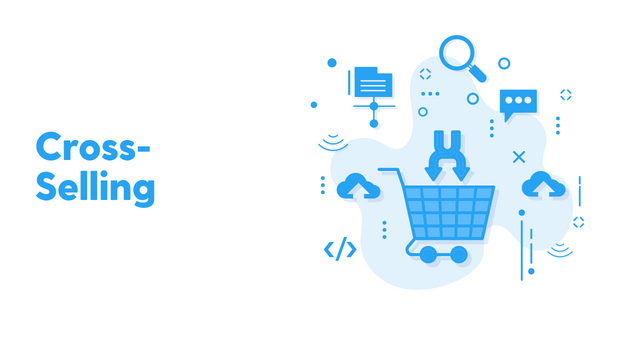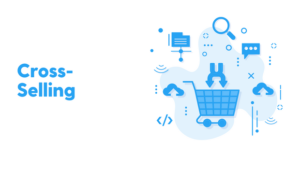Cross-selling is the practice of offering customers additional products or services that complement or enhance the product or service they are already purchasing. It is a sales strategy used by businesses to increase revenue and improve customer satisfaction.
Cross-selling is important because it allows businesses to generate additional revenue from existing customers rather than relying on acquiring new customers. By offering related products or services, businesses can also increase the perceived value of the original purchase, resulting in higher customer satisfaction.
Cross-selling can help businesses to build stronger relationships with their customers by providing them with a more comprehensive solution to their needs.
Cross Selling vs Upselling
Upselling encourages customers to purchase a higher-end or more expensive version of the product or service they are already interested in. For example, a car salesperson may suggest that a customer upgrade from a basic model to a higher-end model with more features.
On the other hand, a cross-selling example would be a car salesperson who may suggest that a customer also purchase an extended warranty or a maintenance package with their new car.
Both upselling and cross-selling are effective strategies for increasing sales, but they have different focuses. Upselling focuses on increasing the value of the original purchase, while cross-selling focuses on expanding the number of products or services sold to the customer.
Examples of effective upselling and cross-selling techniques include offering bundled packages, suggesting complementary products or services, and using personalized recommendations based on the customer’s previous purchases or interests.
To implement upselling and cross-selling, companies must train their sales team and educate them on the products and services they sell. They should also use data analysis to get to know their customers, identify their needs and preferences, and offer tailored solutions to meet those needs.
Cross Selling in eCommerce
There are a few ways that eCommerce brands can use cross-selling to increase revenue, such as:
- Product recommendations: eCommerce businesses can use algorithms to recommend related products to customers based on their browsing and purchase history. This can effectively increase revenue as customers are more likely to purchase related products that align with their interests. Read more – Predictive Analytics
- Upselling and Downselling: eCommerce businesses can use upselling techniques to encourage customers to purchase higher-priced or upgraded versions of products, or downselling techniques to suggest lower-priced or simpler versions of products.
- Bundle deals: eCommerce businesses can offer bundle deals that include multiple products or services at a discounted price. This can be an effective way to increase revenue as customers are more likely to purchase multiple items when they are offered at a discounted price.
Personalized Recommendations as a Cross Selling Strategy
Personalized recommendations are a powerful cross-selling strategy in eCommerce. By using the data they collect on their customers’ browsing and purchase history, eCommerce businesses can make recommendations that are more likely to be accepted. This can include:
- Product recommendations: By analyzing customer data, e-commerce businesses can recommend products that align with the customer’s interests and needs.
- Personalized email marketing: By analyzing customer data, e-commerce businesses can personalize email marketing campaigns to include product recommendations that align with the customer’s interests and needs.
- Personalized landing pages: By analyzing customer data, e-commerce businesses can personalize landing pages to include product recommendations that align with the customer’s interests and needs.
Also, read:
Using Customer Data for Personalized Recommendations
To use customer data to create effective personalized recommendations, you can use a variety of techniques, such as:
- Collaborative filtering: This method uses the past behavior of customers with similar interests to make recommendations.
- Content-based filtering: This method uses the past behavior of a specific customer to make recommendations.
- Hybrid approach: This method combines both collaborative and content-based filtering to make recommendations.
Examples of successful personalized recommendations in e-commerce:
- Amazon’s “Customers who bought this item also bought” feature is an example of collaborative filtering.
- Netflix’s “Because you watched” feature is an example of content-based filtering.
- Spotify’s “Discover Weekly” playlists, personalized based on a listener’s past behavior and habits, is an example of a hybrid approach.
Also, read:
Product Bundling as a Cross Selling Strategy
Product bundling is a marketing strategy in which a company sells several products as a single combined package. This can be an effective way to increase sales, as customers may be more likely to purchase multiple items at once if they are bundled together at a discounted price. For example, a software company might bundle its word processing, spreadsheet, and presentation programs together in a “suite” package.
Benefits of using product bundling as a cross-selling strategy include:
- Increased sales: Bundling products together can increase sales as customers may be more likely to purchase multiple items at once.
- Increased customer loyalty: Offering bundled products can create a sense of value for customers and encourage them to return for future purchases.
- Increased profit margins: Bundling products together can also lead to increased profit margins as the overall price of the bundle can be higher than the individual products sold separately.
Examples of successful product bundling in different industries include:
- Software industry: Microsoft Office Suite, Adobe Creative Suite
- Retail industry: Clothing stores bundle matching items such as a shirt and tie, or a dress and jacket
- Food industry: A meal deal that includes a main dish, side, and drink
To create effective product bundles, consider the following:
- Understand your customers: Understand what products your customers need and want, and bundle them in a way that provides value.
- Create a sense of value: Bundle products together to provide a sense of value for the customer by offering a discounted price or added bonus items.
- Use complementary products: Bundle products that complement each other and are often used together to create a sense of convenience for the customer.
- Test and experiment: Test different bundle options and see which ones work best for your customers.
Cross Selling in Retail: Add-on Sales
One common way retailers use cross-selling is through add-on sales, where they suggest additional items that complement the customer’s initial purchase.
Add-on sales can be an effective cross-selling strategy for retailers because it allows them to increase the overall value of a customer’s purchase and improve the customer’s overall shopping experience.
Examples of successful add-on sales in retail include:
- A clothing store suggests a belt to go with a pair of pants.
- A shoe store suggesting insoles to go with a new pair of shoes.
- A home goods store suggests matching towels to go with a new bathrobe.
To train your staff to offer add-on products and services effectively, consider the following:
- Provide your staff with product knowledge: Make sure your staff is knowledgeable about the products and services you offer, including the features and benefits of different products.
- Encourage your staff to listen actively: Encourage your staff to listen to customers actively and to pay attention to their needs and preferences. This will help them make personalized recommendations that align with the customer’s needs.
- Encourage your staff to use positive language: Encourage them to use positive language and focus on the benefits of the products and services they’re recommending. Avoid using negative language or making comparisons to competitors.
- Provide your staff with a script: Provide your staff with a script that guides them through the process of offering add-on products and services. This can be helpful for new staff members or for staff who need additional support.
- Give your staff the freedom to be creative: Give your staff the freedom to be creative and to find new ways to offer add-on products and services. This will help them to be more successful in their sales efforts.
Example of Add-on Sales Script
Customer: Hi, I’m looking for a new pair of running shoes.
Salesperson: Great! We have a wide selection of running shoes to choose from. Can you tell me a little bit about what you’re looking for in a running shoe?
Customer: I need a shoe with good support and a lot of cushioning.
Salesperson: Our new running shoe model has a lot of cushioning and great support. And if you buy it now, we’re offering 20% off on a pair of running socks that will perfectly match with your new shoes and will enhance the overall running experience. Would you like to take a look at it?
Customer: Sure!
Cross Selling in Banking
Cross-selling in banking refers to the practice of offering additional financial products or services to existing customers.
Examples of cross-selling in banking include:
- Offering credit cards to checking account holders
- Selling investment products to savings account holders
- Offering personal loans to customers who have mortgages with the bank
- Offering insurance products such as life, health, and property insurance
- Offering wealth management services to high-net-worth individuals
Banks use a variety of tactics to cross-sell products, such as targeted marketing campaigns, in-person sales pitches, and digital platforms like online banking and mobile apps. Banks also use data analytics to identify customers who are most likely to be interested in a particular product and tailor their cross-selling efforts accordingly.
Cross-selling enables banks to increase revenue by expanding the range of products and services they offer and encouraging customers to do more business with the bank. This can lead to increased customer loyalty and retention, as customers are likelier to stick with a bank that offers a wide range of products and services that meet their financial needs.
Cross Selling in Insurance: Policy Bundling
Cross-selling in insurance refers to the practice of offering additional insurance policies or services to existing customers. Policy bundling is a type of cross-selling strategy used by insurance companies that offer multiple insurance policies as a package deal.
Insurance companies use policy bundling as a cross-selling strategy to increase revenue by expanding their relationships with current customers and increasing the amount of business they do with them. Policy bundling can also help to increase customer loyalty and retention, as customers are more likely to stick with an insurance company that offers a wide range of products and services that meet their insurance needs.
Policy bundling can save customers money by offering a discounted price for purchasing multiple policies. Additionally, policy bundling can provide more comprehensive coverage as it allows customers to bundle policies that complement each other, such as home and auto insurance or health and life insurance.
Examples of successful policy bundling in the insurance industry include:
- Bundling home and auto insurance: Insurance companies that bundle home and auto insurance policies often offer a discount to customers who purchase both policies with them.
- Bundling health and life insurance: Some insurance companies offer discounted rates to customers who bundle their health and life insurance policies together.
- Bundling travel insurance with health insurance: Some health insurance companies may bundle travel insurance with their health insurance policies.
Cross Selling in Real Estate: Add-on Services
Cross-selling in real estate refers to the practice of offering additional services or products to existing customers. Add-on services are a type of cross-selling strategy used by real estate agents in which they offer additional services to customers buying or selling a property.
Real estate agents use add-on services as a cross-selling strategy to increase revenue by expanding their relationships with current customers and increasing the amount of business they do with them. Add-on services can also help to increase customer loyalty and retention, as customers are more likely to stick with an agent that offers a wide range of products and services that meet their real estate needs.
Examples of successful add-on services in real estate include:
- Home staging: Real estate agents may offer home staging services to help sellers prepare their property for sale.
- Home inspection: Real estate agents may offer home inspection services to help buyers understand the condition of a property before purchasing it.
- Property management: Some real estate agents may offer property management services to help landlords manage their rental properties.
- Mortgage brokerage: Some real estate agents may offer mortgage brokerage services to help buyers find the best mortgage rates and products.
- To offer and market add-on services, real estate agents can:
- Include information about add-on services in their marketing materials and on their websites
- Offer add-on services as part of their standard package of services
- Bring up add-on services in conversations with clients and find out what additional services they may be interested in
- Offer discounts or incentives to customers who purchase multiple services.
Cross Selling in Services: Upselling
Cross-selling in services refers to the practice of offering additional services or upgrades to existing customers.
Service-based businesses use upselling as a cross-selling strategy to increase revenue by expanding their relationships with current customers and increasing the amount of business they do with them. Upselling can also help to increase customer loyalty and retention, as customers are more likely to stick with a service provider that offers a wide range of products and services that meet their needs.
To identify and offer additional services, service-based businesses can:
- Use customer data and feedback to understand what additional services customers may be interested in.
- Identify complementary services that can be offered as an upgrade.
- Train employees to recognize opportunities to upsell and offer additional services.
- Offer a menu of services to customers and highlight the benefits of each.
- Examples of successful upselling in various service industries include:
- Hair salons: Upselling hair treatments such as color, highlights or conditioning treatments
- Spa and wellness centers: Upselling spa packages that include multiple services, such as massages and facials.
- Car service: Upselling car detailing services and maintenance plans.
- Hotels: Upselling room upgrades, late check-out, and other amenities.
- Consulting service: Upselling additional analysis, training, or consulting hours.
Cross Selling in Telecommunications: Value-Added Services
Telecommunications companies use value-added services as a cross-selling strategy to increase revenue by expanding their relationships with current customers and increasing the amount of business they do with them. Value-added services can also help to increase customer loyalty and retention, as customers are more likely to stick with a telecommunications company that offers a wide range of products and services that meet their needs.
Examples of value-added services offered by telecommunications companies include:
- Call forwarding: Allows customers to forward calls to another number, such as a mobile phone or office phone.
- Caller ID: Allows customers to see the caller’s phone number before answering the call.
- Call waiting: Allows customers to put a call on hold and answer another call that comes in.
- Voicemail: Allows customers to receive and listen to voice messages left by callers when the phone is not answered.
- International calling: Allows customers to make international calls at a discounted rate.
To take advantage of value-added services, customers can: - Review the value-added services offered by their telecommunications provider and select those that best meet their needs.
- Ask their telecommunications provider about special promotions or value-added services discounts.
- Take advantage of bundled services to get better value for their money.
- Use these services as part of their business strategy and for their personal use to make the most out of their telecommunications services.
Cross Selling in Hospitality: Room Upgrades
Hotels use room upgrades as a cross-selling strategy to increase revenue by offering customers the opportunity to purchase a higher-end room or suite.
Examples of successful room upgrades in the hospitality industry include:
- Executive or Club level rooms: These rooms offer additional amenities such as access to a private lounge or concierge service.
- Suites: Hotels may offer larger rooms or suites with additional living space and amenities.
- Balcony or ocean-view rooms: Upgraded rooms that offer a balcony or ocean-view that can be particularly appealing to customers looking for a more luxurious experience.
To effectively upsell room upgrades and other add-on services, hotels can: - Train employees to recognize opportunities to upsell and offer room upgrades and additional services.
- Use customer data and feedback to understand what room upgrades and additional services customers may be interested in.
- Offer special promotions or discounts on room upgrades and additional services.
- Highlight the benefits of room upgrades and additional services in marketing materials and on the hotel’s website.
Conclusion
In conclusion, upselling and cross-selling are powerful strategies for increasing average order value and customer lifetime value. Brands can effectively boost sales and profits by identifying the right customers and using targeted strategies. However, with limited resources, knowing which customers are most likely to make additional purchases can be challenging.
This is where Saras Analytics can help you set up tracking conversions across multiple channels and use data-driven techniques such as cohort analysis, RFM analysis, customer segmentation, and predictive analytics to help you make informed decisions for your business growth.
To learn more about how Saras Analytics can help you boost sales and profits through upselling and cross-selling, contact us for a free consultation.













